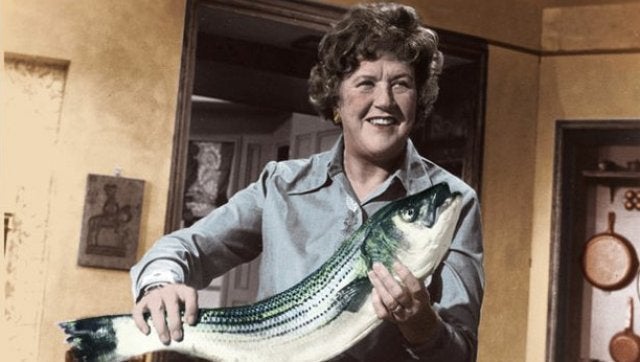
With Aug. 15 being the 100th anniversary of Julia Child's birth, I figured a post about food in novels might be appropriate.
I'm not fond of many Child recipes (too much meat and butter), but I do like many books with chow in their chapters. Heck, food in fiction can be as compelling as love in literature.
But enough alliteration. A novel's food-related content might be pleasant, turn a reader's stomach, or set off reactions between those two extremes -- sometimes in the same book.
One novel with a (mostly) pleasant food motif is Joanne Harris' Chocolat (1999), which inspired the well-known movie. It's about a woman, Vianne Rocher, who opens a small chocolate shop in a repressed French village. Magical happenings ensue -- as does conflict.
In the turn-a-reader's-stomach category is Upton Sinclair's The Jungle, which revealed many revolting facts about the meat industry. That novel was published in 1906, but remains relevant given today's corporatized food system, the abysmal treatment of animals by factory farms, and inadequate government regulation.
There's also the orgiastic food scene in Honore de Balzac's The Magic Skin (1831), which might make you forever refrain from overeating. (Watching this classic Monty Python sketch could do the trick, too.)
And there's the poor, hungry title character in Charles Dickens' Oliver Twist (1838) saying one of the most famous lines in literature: "Please, sir, I want some more."
In the mix-of-positive-and-negative category, there are more food-filled books than one can count. The market in Emile Zola's The Belly of Paris (1873) is quite a bountiful place, but some of the people staffing the stalls are far from likable.
I also think of J.K. Rowling's Harry Potter series, in which Harry is poorly fed at the Dursleys' home but experiences some lavish feasts in the Hogwarts dining hall (feasts particularly enjoyed by Ron Weasley -- except when he receives a "howler" from mom).
Or the tense meals Valancy Stirling of L.M. Montgomery's The Blue Castle (1926) eats with her narrow-minded family, and, later, the wonderful repasts she shares with Barney in their idyllic island home.
Food is a huge part of T.C. Boyle's historical novel The Road to Wellville (1993), which I'm currently reading. There's the meatless fare at John Harvey Kellogg's "temple of health" in Battle Creek, Michigan, as well as the table-groaning oyster and steak dinners some of Boyle's non-vegetarian characters ingest.
Suzanne Collins' The Hunger Games (2008) also often focuses on food: Katniss Everdeen's struggle to feed her family in District 12, the memorable moment when Peeta tosses the famished Katniss a loaf of bread, the savory meals the "powers that be" give Katniss and other contestants before the brutal Hunger Games begin, and the difficulty in obtaining sustenance as the contestants fight to stay alive during their gladiatorial ordeal.
In Darryl Brock's baseball novel If I Never Get Back (1990), the time-traveling Sam Fowler is forced to eat mediocre 19th-century-American "cuisine" until, out of desperation, he goes to a Chinese neighborhood and pays someone to cook him a delicious meal. He also introduces an early form of hot dogs to the Cincinnati Red Stockings' ballpark.
Speaking of frankfurters, Milton the dad in Jeffrey Eugenides' Middlesex (2002) operates a successful hot dog chain during part of his life.
Foods are given human qualities by Marian McAlpin, the conflicted protagonist in Margaret Atwood's seriocomic first novel: The Edible Woman (1969). That makes it hard for Marian to eat these "living" items, which sort of symbolizes the way marriage to her fiance would devour her independence and put her in a more traditional role than she wants.
Last but not least, there's the famous scene in Alice Walker's The Color Purple (1982) where Celie secretly spits in that guy's glass of water. Not sure if water can be called food, but I've heard it's rather necessary for readers and other humans to have...
What are your favorite (and not-so-favorite) novels with at least some mentions of food?
---
Dave Astor's memoir Comic (and Column) Confessional (Xenos Press) has been published. Signed copies are now available; if you'd like to buy one, contact Dave at dastor@earthlink.net. There's also a just-posted Amazon listing here. (Several things in the listing need to be corrected; for instance, the book came out in July 2012, not "May 22, 2008." Given that Dave didn't start writing the book until 2009, finishing it in 2008 would have been quite an achievement!)